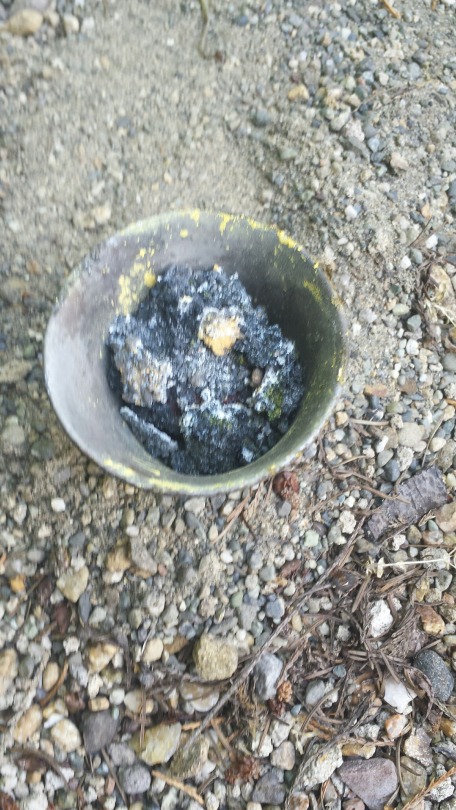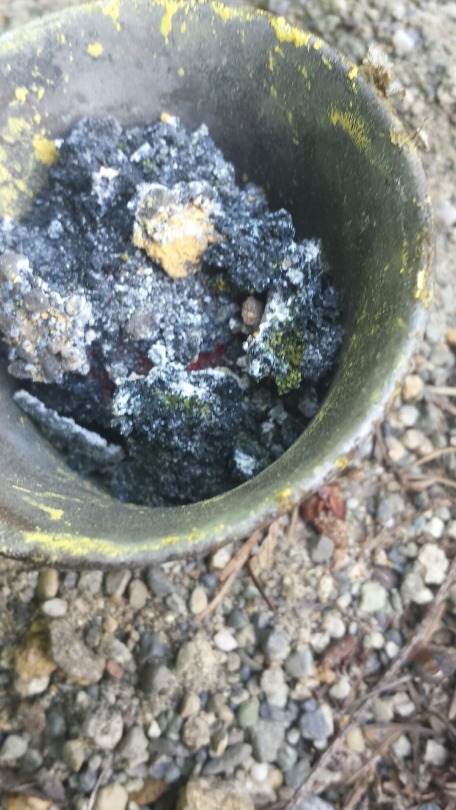elementcollector1
International Hazard
    
Posts: 2684
Registered: 28-12-2011
Location: The Known Universe
Member Is Offline
Mood: Molten
|
|
Praseodymium from Glaze
So I recently decided to revisit a curious little thing I'd found at Seattle Pottery Supply last year. It was a small bag of yellow powder, marked
'Praseodymium'. Content composition: 'PrZrSi'. So, either a mix of praseodymium and zirconium silicates, or some sort of imitation. I decided to try
getting the praseodymium, if there was any, into a soluble form.
First attempt was melting with just NaOH. Nothing much happened. The NaOH offgassed as it melted (presumably water), and the yellow powder remained
yellow. I did notice a bit of powder that had fallen onto the heating coils themselves - this turned a curious pinkish-brown. No idea what that was
about.
Quenching the mix in water (in an attempt to not have to chisel it out of my crucible) resulting in a) an explosion and 2) molten droplets of NaOH on
my arms. Six years into this hobby, and that was the second most embarrassing mistake I've made this month. Recovered the majority of the fused
powder, as the rest had to be pressure-hosed off of my driveway. Fun times.
Anyway, from this first attempt, I discovered that while the yellow powder remained visibly untouched, something had happened: The
supernatant solution was a light green, reminiscent of dilute Fe(II). Any ideas on this? I've decanted most of it, and it doesn't much seem to change
color.
Going to try a second attempt, this time with a mix of sodium nitrate and sodium hydroxide. What should I be looking for? The very dark brown
Pr6O11? A greenish praseodymium hydroxide? Something else altogether?
And what about the zirconium, where does that play in? Can I extract that too?
Elements Collected:52/87
Latest Acquired: Cl
Next in Line: Nd
|
|
|
Texium
Administrator
       
Posts: 4516
Registered: 11-1-2014
Location: Salt Lake City
Member Is Offline
Mood: PhD candidate!
|
|
I don't know how well that method will work for extracting praseodymium, as praseodymium is not amphoteric and won't form "praseodymates" when fused
with a strong base like that. It might be a shot in the dark, but the best thing to try might be to attempt to reduce it with aluminum or magnesium
powder in a thermite like mixture, probably with some chlorate in there to give it a boost. Then try dissolving the slag in HCl and see what you get.
More likely than not, in these pottery type compositions, though it says praseodymium there's probably other lanthanides mixed in with it, because it
wouldn't make economic sense to go through the difficult process of separating praseodymium from the other lanthanides when it's being used as a
pottery glaze.
|
|
|
Argentum
Harmless

Posts: 36
Registered: 18-9-2014
Location: El culo del mundo
Member Is Offline
Mood: UV light
|
|
Well, I am sure that the light greenish color is given by Pr(III), and not dilute Fe(II). Wikipedia says that Pr is yellow-green in water solution,
and that it is used to give glass various shades of yellow-green. So it would not be strange to see some form of praseodymium in a pottery supply. Now
the trouble is to isolate it.
|
|
|
elementcollector1
International Hazard
    
Posts: 2684
Registered: 28-12-2011
Location: The Known Universe
Member Is Offline
Mood: Molten
|
|
Another possibility for that green color is chromium(III), as the mixture was melted in a stainless-steel crucible (and chromium is amphoteric,
especially when molten NaOH is concerned).
I tried zts16's suggestion with Mg metal just now, and I'm pleased to report some evidence of success.


Seen on the right is a green stain of... something, which quickly faded to blackish-brown on exposure to air. This was present throughout the
reacted mixture. Praseodymium oxide, maybe?
The mix is currently dissolving in diluted sulfuric acid at high temperatures (no external heating, this is simply from the mixing of sulfuric acid
and water plus the quenching of the still-hot material). Reminds me exactly of 'magnet sulfate' dissolution so far, in that it's a swirling mix of
gray particles that fizz slowly. Hopefully it'll settle out to reveal a color - there were a few rocks in the mix, so the praseodymium likely is
nowhere near pure at this stage, but hopefully it'll at least be in solution.
Elements Collected:52/87
Latest Acquired: Cl
Next in Line: Nd
|
|
|
elementcollector1
International Hazard
    
Posts: 2684
Registered: 28-12-2011
Location: The Known Universe
Member Is Offline
Mood: Molten
|
|
Upon further discussion and a little experimentation, the acid mixture was changed to HCl and H2O2, which foamed rapidly (nearly
overfoaming the beaker) and generating quite a bit of chlorine.
On a more positive note, the solution is now a lovely lime green!
Elements Collected:52/87
Latest Acquired: Cl
Next in Line: Nd
|
|
|
blogfast25
International Hazard
    
Posts: 10562
Registered: 3-2-2008
Location: Neverland
Member Is Offline
Mood: No Mood
|
|
For ziconium use pottery grade Zircon (ZrSiO4) (glaze opacifier) or roll-on anti-perspirant as source materials. There are threads on both
here.
Fusing a Zircon containing glaze with NaOH, then treatment with water will first give sodium zirconate (and sodium silicate), then hydrated zirconia
and silica gel. The former is soluble in hot, strong HCl, if you act quickly.
Quote: Originally posted by elementcollector1  | Upon further discussion and a little experimentation, the acid mixture was changed to HCl and H2O2, which foamed rapidly (nearly
overfoaming the beaker) and generating quite a bit of chlorine.
On a more positive note, the solution is now a lovely lime green! |
So it is possible your PrCl3 is now contaminated with ZrOCl2...
[Edited on 23-7-2016 by blogfast25]
|
|
|
blogfast25
International Hazard
    
Posts: 10562
Registered: 3-2-2008
Location: Neverland
Member Is Offline
Mood: No Mood
|
|
Another possibility is to fuse the 'PrZrSi' with an excess of anh. sodium bisulphate (NaHSO4) This might convert the Pr to its sulphates,
while leaving the Zr and Si as their oxides.
Neutralise with strong ammonia, filter and wash to remove sulphate. Then leach filter cake with strong HCl/H2O2, to extract
PrCl3.
[Edited on 23-7-2016 by blogfast25]
|
|
|